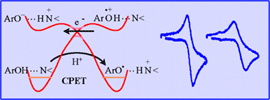Publication
621
J. Am. Chem. Soc , 129, 9953-9963, 2007.
DOI:
10.1021/ja071150d
|
|
|
|
|
|
 |
Adiabatic and Non-adiabatic Concerted Proton-Electron Transfers. Temperature Effects in the Oxidation of Intramolecularly Hydrogen-Bonded Phenols |
|
|
|
|
|
|
|
Cyrille Costentin, Marc Robert, and Jean-Michel Savéant
Contribution from the Laboratoire d'Electrochimie Moléculaire, Unité Mixte de Recherche Université, CNRS No 7591, Université de Paris 7-Denis Diderot, 2 place Jussieu, 75251 Paris Cedex 05, France
The one-electron electrochemical and homogeneous oxidations of two closely similar aminophenols that undergo a concerted proton-electron transfer reaction, in which the phenolic proton is transferred to the nitrogen atom in concert with electron transfer, are taken as examples to test procedures that allow the separate determination of the degree of adiabaticity and the reorganization energy of the reaction. The Marcus (or Marcus-Hush-Levich) formalism is applicable in both cases, but not necessarily in its adiabatic version. Linearization of the activation-driving force laws simplifies the treatment of the kinetic data, notably allowing the use of Arrhenius plots to treat the temperature dependence of the rate constant. A correct estimation of the adiabaticity and reorganization energy requires the determination of the variation of the driving force with temperature. Application of these procedures led to the conclusion that, unlike previous reports, the homogeneous reaction is non-adiabatic, with a transmission coefficient of the order of 0.005, and that the self-exchange reorganization energy is about 1 eV lower than previously estimated. With such systems, the intramolecular reorganization energy, although sizable, is in fact rather modest, being only slightly larger than that for the outer-sphere electron transfer that produced the cation radical. The electrochemical reaction is, in contrast, adiabatic, as revealed by the temperature dependence of its standard rate constant obtained from cyclic voltammetric experiments. This difference in behavior is deemed to derive from the effect of the strong electric field within which the electrochemical reaction takes place, stabilizing a zwitterionic form of the reactant (in which the proton has been transferred from oxygen to nitrogen). Taking this difference in adiabaticity into account, the magnitudes of the reorganization energies of the two reactions appear to be quite compatible with one another, as revealed by an analysis of the solvent and intramolecular contributions in both cases. |

